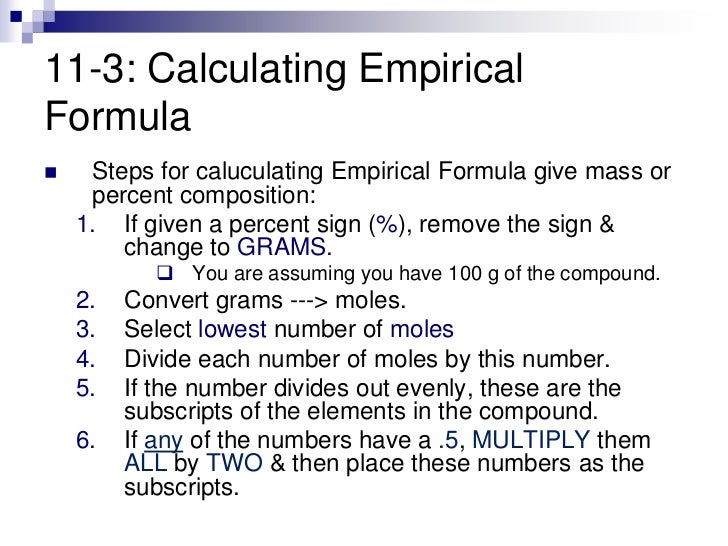How To Calculate Empirical Formula Given Percentages - Divide all moles by smallest moles:
How To Calculate Empirical Formula Given Percentages - Divide all moles by smallest moles:. Assume a 100 g sample of the compound so that the given percentages can be directly converted into grams. If you're given the percent composition of a compound, you can find the empirical formula for it. See full list on conquerchemistry.com 4) write the empirical formula: Since the moles of all the elements are whole numbers, we are done.
What is the empirical formula for a compound containing 38.8% carbon, 16.2 % hydrogen, and 45.1% nitrogen? Calculate empirical formula when given percent composition data. How do you calculate empirical formulas? Feb 09, 2021 · steps to determine empirical formula: Apr 10, 2016 · take the percentages divide them by the atomic relative mass of the atoms.after dividing you will get the values.divide all the values with the smallest value which you get and by doing this you will get a ratio and this will be the empirical formula.

How to calculate empirical/molecular formulas?
This changes the percents to grams: Since the moles of all the elements are whole numbers, we are done. Next, convert the grams to moles by dividing 29.3 grams by the atomic weight of sodium, which is 22.99 grams, to get 1.274. How do you calculate empirical formulas? I have the shortest method ever to do it, although it's no. You can find the empirical formula of a compound using percent composition data. How would i calculate these empirical formulas? More practice problems even more practice problems as always, if you have any questions, leave a comment below. How to calculate empirical/molecular formulas? Divide the molar mass of the compound by the molar mass of the empirical formula. Apr 10, 2016 · take the percentages divide them by the atomic relative mass of the atoms.after dividing you will get the values.divide all the values with the smallest value which you get and by doing this you will get a ratio and this will be the empirical formula. In this case, the smallest moles is 3.22 mol of n so we'll divide all the moles by 3.22. What is determined by an empirical formula?
Assume a 100 g sample of the compound so that the given percentages can be directly converted into grams. How would i calculate these empirical formulas? 2) convert the masses to moles: 38.8 g carbon, 16.2 g hydrogen, and 45.1 g nitrogen 2. Divide the molar mass of the compound by the molar mass of the empirical formula.
Use each element's molar mass to convert the grams of each element to moles.
Next, convert the grams to moles by dividing 29.3 grams by the atomic weight of sodium, which is 22.99 grams, to get 1.274. Also let me know if there is any topics you want me to cover. Lets work through this example together and go through it step by step. What is the empirical formula for a compound containing 38.8% carbon, 16.2 % hydrogen, and 45.1% nitrogen? Since the moles of all the elements are whole numbers, we are done. You can see a l. See full list on conquerchemistry.com Shows how to determine the empirical and molecular formulas for a compound if you are given the percent composition and the molecular weight. Apr 10, 2016 · take the percentages divide them by the atomic relative mass of the atoms.after dividing you will get the values.divide all the values with the smallest value which you get and by doing this you will get a ratio and this will be the empirical formula. Divide the molar mass of the compound by the molar mass of the empirical formula. This leaves us with 1 c, 5 h, 1 n 4. To be able to find the molecular formula, you'll need to given the molar mass of the compound. I have the shortest method ever to do it, although it's no.
Feb 09, 2021 · steps to determine empirical formula: See full list on conquerchemistry.com 38.8 g carbon, 16.2 g hydrogen, and 45.1 g nitrogen 2. Shows how to determine the empirical and molecular formulas for a compound if you are given the percent composition and the molecular weight. 2) convert the masses to moles:

What is the empirical formula for a compound containing 38.8% carbon, 16.2 % hydrogen, and 45.1% nitrogen?
Divide the molar mass of the compound by the molar mass of the empirical formula. What is the empirical formula for a compound containing 38.8% carbon, 16.2 % hydrogen, and 45.1% nitrogen? More practice problems even more practice problems as always, if you have any questions, leave a comment below. 2) convert the masses to moles: Feb 09, 2021 · steps to determine empirical formula: This will give you the molecular formula. Assume a 100 g sample of the compound so that the given percentages can be directly converted into grams. Next, convert the grams to moles by dividing 29.3 grams by the atomic weight of sodium, which is 22.99 grams, to get 1.274. This should give you a whole number 2. Use each element's molar mass to convert the grams of each element to moles. If you're given the percent composition of a compound, you can find the empirical formula for it. What is determined by an empirical formula? How would i calculate these empirical formulas?
Next, convert the grams to moles by dividing 293 grams by the atomic weight of sodium, which is 2299 grams, to get 1274 how to calculate empirical formula. Divide all moles by smallest moles: